Plant Your Own Pollinator Paradise
Welcome to Keweenaw Wild Ones’ final native plant sale of 2023. Check out the plants below and think about what you’d like in your garden. Then visit our shop and place your order. Simple!
This is a great time to plant—and a great time to save! Some of our favorite pollinator plants are now ON SALE: anise hyssop, wild bergemot, showy goldenrod and more.
Fall is a wonderful time to create a wildlife oasis in your yard. Plants have time to set roots before the winter snows. Then when the temperature rises, they are all set to thrive in the spring. We are offering a selection of native plants to get you started gardening for butterflies, birds, and pollinators.
Love native plants? Want to take advantage of pre-sales and get a discount? Join the Wild Ones Keweenaw chapter! Sign up here!
How our sales work
Our plant sales are online, but we are not Amazon. If you have trouble checking out, email your order to [email protected].
Otherwise, here’s what to do:
- Browse our plant selection below. You can link to detailed plant information sheets for each offering.
- Go to our Shop and pick out your plants.
- Check out. You may use PayPal or “pay on delivery.”
- If you have trouble checking out, email your order to wildoneskeweenaw at gmail.com.
- Pick up your order, bringing cash or a check if you have not paid with PayPal. You will receive an email reminding you when and where.
WHEN: 10 a.m.–noon, Saturday, September 9, 2023
1–3 p.m., Sunday, September 10, 2023
WHERE: 1284 Hickory Lane, Houghton
Questions? Email [email protected]
Love native plants? Want to take advantage of pre-sales and discounts? Join the Wild Ones Keweenaw chapter! Sign up here!
Read about these fascinating plants, then visit our shop.

Anise Hyssop Agastache foeniculum
Super easy to grow and very long blooming, this pollinator magnet has a lovely aspect in the garden and fits in most anywhere that has lots of sun and well-drained soil. Its survival strategy is to spread seed abundantly, so don’t be surprised if it turns up in cracks in the sidewalk. Anise hyssop earned its name honestly; its leaves have a lovely citrusy-minty-licorice scent that make a great garnish.
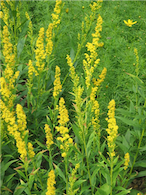
Blue-Stemmed Goldenrod Solidago caesia
Blue-stemmed Goldenrod is one of only two native goldenrods that do well in woodland shade. The other, Zigzag Goldenrod, spreads by rhizomes and is more aggressive. Both are beautiful; take your pick. The “blue” in the name is derived from the stems that may be blue-gray in mature plants. The flowers attract a wide variety of insects; it has been designated as a plant that is of special value to native bees by the Xerces Society for Invertebrate Conservation.
Preferring light shade, Blue-stemmed Goldenrod can be added to open woodland gardens, borders, cottage and/or butterfly gardens. The plant is considered to be deer resistant, although deer may graze on the lower leaves.
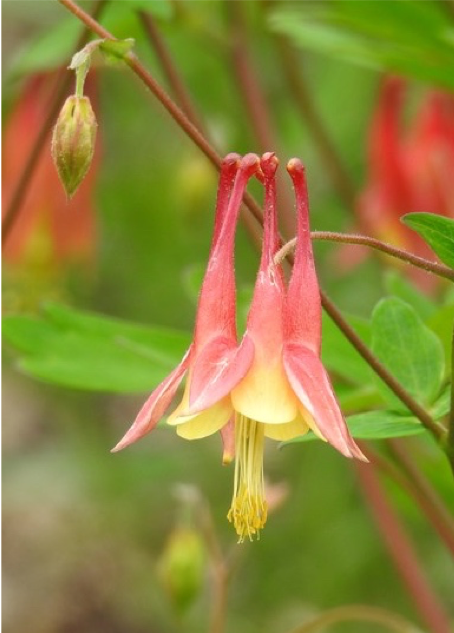
Columbine Aquilegia canadensis
Columbine has everything going for it: it’s widely adaptable, it’s beautiful, hummingbirds love it, and it pops up in the most unexpected places. Should you grow columbine? Of course you should.
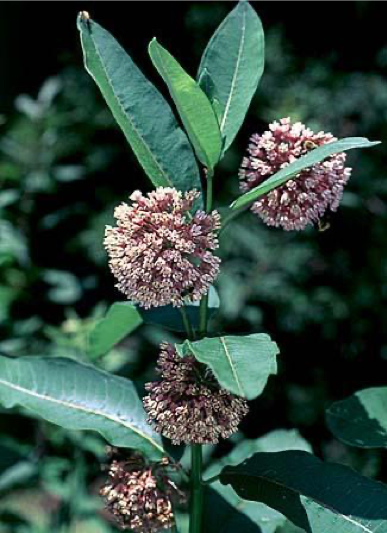
Common Milkweed Asclepias syriaca
Will grow in nearly all soils, so long as they aren’t too wet. Plant in full to partial sun 1 foot apart. Beloved by butterflies, especially monarchs, which only lay their eggs on milkweed plants. Common milkweed is an aggressive spreader where it is happy, so give this plant some room to run and you won’t be disappointed.
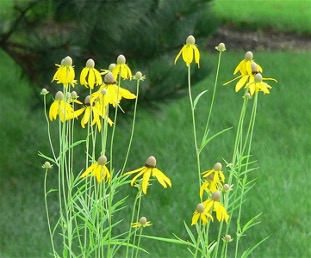
Gray-headed Coneflower Ratibida pinnata
Found in the wild along woodland edges, it adapts readily to the garden, where you can appreciate its shuttlecock flowers up close. Fair warning: those long, graceful stems do tend to flop, so consider the back of the border or tucking them amidst sturdier customers like purple coneflower.
Gray-headed coneflower is drought-tolerant, always a plus with our unpredictable summers, and deer resistant.

Hairy Mountain Mint
Pycnanthemum verticillatum var. pilosum
People find hairy mountain mint pretty, but pollinators consider it irresistable. It’s easy to grow, pretty, a nice size… it might be a spreader, so when you plant it, consider the neighborhood.
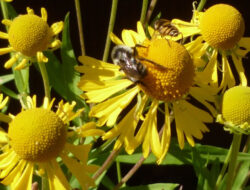
Helen’s Flower/Dogtooth Daisy
Helenium autumnale
This delightful plant loves full sun and all kinds of soils, doing best if they are damp. The charming flowers bloom en masse late in the season—maybe plant several together in a nice clump. The genus is thought to have been named by Linnaeus (the guy who began giving plants scientific names) for the world’s most beautiful woman, Helen of Troy. Legend has it that the flowers sprung up from the ground where her tears fell.
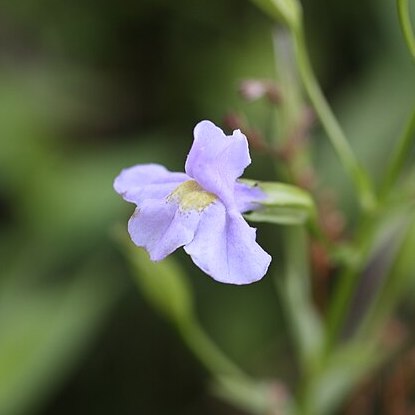
Monkey Flower
Mimulus ringens
A tough-yet-delicate wetland plant that will be happy in the moist places of your garden. You can also plant it on shorelines or put it in a gallon container and sink it along the edges of streams and ponds. This summer bloomer attracts hummers and is easy to grow, so long as you plant it where it belongs.
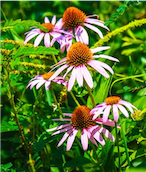
Purple Coneflower Echinacea purpurea
The gateway plant leading to a lifelong addiction to native gardening. With a handful of other natives (black-eyed Susan comes to mind), purple coneflower can lure even the most conventional gardener to consider transforming a corner of their yard into a wild paradise. It’s gorgeous, familiar, adaptable, and well-behaved. Not to mention easy to grow in average well-drained soil in full sun to partial shade.
And yes, even though purple coneflower looks like it could have leapt off the pages of a conventional seed catalog, it is definitely loved by birds and pollinators—not just us humans.

Showy Goldenrod Solidago speciosa
Showy Goldenrod deserves to be planted a lot more than it is. This is one fantastic fall bloomer, flowering a little later than most goldenrods and thereby providing a late season nectar source for Monarch butterflies and other pollinators. It has a showy feathery plume on a red stem and looks good paired with Black-eyed Susan, Stiff Gentian, Blazing Stars, and all by its gorgeous self.
Showy Goldenrod tolerates a range of soils as long as there is good drainage. The plant can be grown in prairies, fields, thin rocky soil and on dry, open, sandy ground.
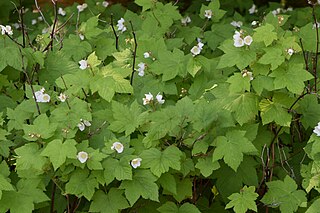
Thimbleberry Rubus parviflorus
Thimbleberries are the signature fruit of the Keweenaw, and while they are found in the wild, not that many folks are lucky enough to have them in their gardens. These canes were dug up and potted as part of a plant rescue. They grow in most soils (except wet) and in everything from full sun to shade, but if you want fruit, plant them in a sunnier spot.
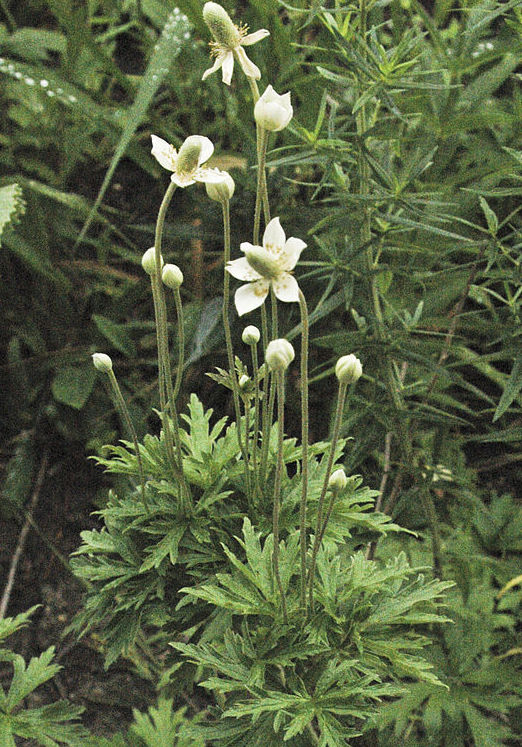
Thimbleweed
Anemone cylindrica
This pretty little creature looks like it belongs in an elfen glade, but it’s actually a tough customer, preferring dry open spaces and rocky soil, in sun to part shade. The greenish white flowers fruit into a greenish white elongated cluster that resembles a thimble. FYI: Like a number of other garden plants (rhododendron, foxglove, delphinium) it is toxic, though despite this deer will sometimes snip the flower heads off.
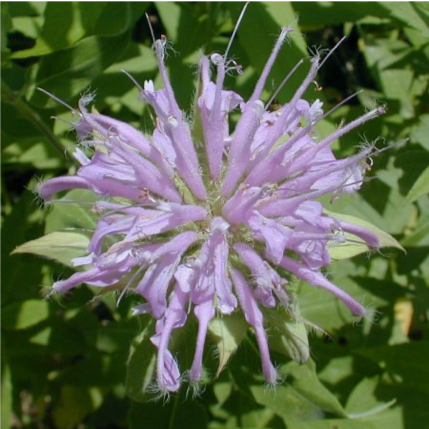
Wild Bergamot
Monarda fistulosa
A showy addition to the native garden, wild bergamot has a special advantage in being on deer’s do-not-eat list. The flowers are gorgeous and a favorite of hummingbirds. The long bloom period provides a continuing source of food for many pollinators.
Fair warning: It is susceptible to mildew. Good air circulation helps, as does dividing large plants every two to three years. That said, a little mildew is a small price to pay for this treasure.
